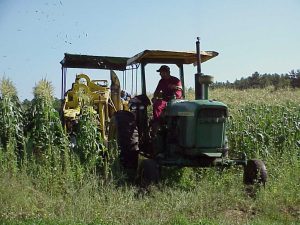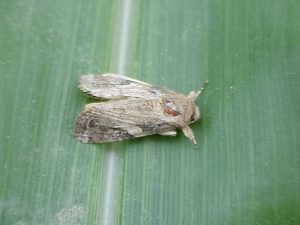Sweet Corn IPM Newsletter No. 12 – September 9, 2022
Last Issue for 2022 Sweet Corn IPM Newsletter – No. 12 – September 9, 2022
CORN EARWORM NUMBERS HIGHER
Most Silking Fields Now Require Tight Spray Schedule
This will be the final issue of the Sweet Corn IPM Newsletter for the 2022 season. I would like to thank all of the growers who participated in the program this year, and our team of IPM scouts, including Brooke Martin, Karla Mendoza Yanes and Sean McAuley. Special thanks to Chris Howard for editing and mailing the newsletter and updating our webpage and blog.
SITUATION

Corn harvest is finishing up at many farms, as the intense heat during the summer hastened the maturity of later plantings. Late season pest pressure is largely from corn earworm, as numbers continued to climb at most sites this week.
European corn borer: Larval feeding injury from corn borer was not over the 15% control threshold for pre-silking corn at any of our scouting sites. Moth captures are lower than last week and were not over the 5-moth threshold for silking corn at any location.
Corn earworm: Moth counts increased at most southern locations this week. A 6-day spray interval for silking corn was recommended for Monmouth and Wayne. A 5-day spray schedule was recommended for one site in Wells. A 4-day spray interval was recommended in Biddeford, Bowdoinham, Cape Elizabeth, Oxford, and one Wells site. A 3-day spray interval was recommended at one Dayton site.

Fall armyworm: Fall armyworm moth counts were variable around the state. Some sites saw increased numbers while other sites had no moths. Trap counts were over the three-moth threshold for silking corn in Biddeford, Bowdoinham, Cape Elizabeth, one Dayton site, one Lewiston site, New Gloucester, and Oxford. Only the Lewiston site was not also on a spray schedule for corn earworm, so a single spray for all silking corn was recommended there. Larval feeding damage on leaves and tassels of younger corn was not over threshold at any of the sites this week.
Spotted Wing Drosophila: There is now a very high threat level for any berry fields. Growers should maintain a tight, (5-7 day) spray schedule.
https://extension.umaine.edu/highmoor/category/spotted-wing-drosophila/.
New England Vegetable & Fruit Conference: Hold the date! The Conference is back for a full three days of educational sessions and a large trades show. Please plan to join us in Manchester, NH, December 13-15, 2022.
Annual end of corn season checklist:
- Plow down corn stalks and stubble to destroy overwintering larvae of European corn borer
- Plant a cover crop, such as winter rye, to prevent soil erosion and add organic matter to the soil.
- Take a soil test to determine if lime or other nutrients should be applied.
- Plan to rotate your crops to prevent pests from building up in any one location.
- Evaluate your weed management results; What worked well and what didn’t? Which weeds were the biggest problems? How can you improve control?
Sincerely,
David T. Handley
Vegetable and Small Fruit Specialist
Highmoor Farm UMaine Extension Diagnostic
P.O. Box 179 Research Lab, Pest Mgmt. Unit
52 U.S. Route 202 17 Godfrey Drive
Monmouth, ME 04259 Orono, ME 04473
207.933.2100 1.800.287.0279
Sweet Corn IPM Weekly Scouting Summary
| Location | CEW
Moths |
ECB
Moths |
FAW
Moths |
%Feeding
Damage |
Recommendations / Comments |
| Biddeford | 47 | 0 | 10 | 2% | 4-day spray interval for silking corn |
| Bowdoinham | 12 | 1 | 10 | 7% | 4-day spray interval for silking corn |
| Cape Elizabeth | 38 | 0 | 9 | 4-day spray interval for silking corn | |
| Dayton I | 99 | 0 | 3 | 3-day spray interval for silking corn | |
| Dayton II | 73 | 0 | 1 | 4-day spray interval for silking corn | |
| Garland | 0 | 0 | 0 | No spray recommended | |
| Lewiston | 10 | 1 | 1 | 4-day spray interval for silking corn | |
| Lewiston II | 0 | 2 | 4 | 1 spray on all silking corn for FAW | |
| Monmouth | 4 | 0 | 2 | 6-day spray interval for silking corn | |
| New Gloucester | 51 | 0 | 3 | 4-day spray interval for silking corn | |
| Oxford | 8 | 3 | 5 | 4-day spray interval for silking corn | |
| Palmyra | 0 | 1 | 0 | No spray recommended | |
| Wayne | 2 | 0 | 0 | 6-day spray interval for silking corn | |
| Wells I | 6 | 0 | 0 | 5-day spray interval for silking corn | |
| Wells II | 42 | 0 | 1 | 4-day spray interval for silking corn |
CEW: Corn earworm (Only fresh silking corn should be sprayed for this insect.)
ECB: European corn borer
FAW: Fall armyworm
| European Corn Borer Thresholds
Whorl stage: 30% or more of plants scouted show injury. Pre-tassel-silk: 15% or more of plants scouted show injury. Silk: 5 or more moths caught in pheromone traps in one week. |
Corn Earworm Spray Thresholds for Pheromone Traps
| Moths caught per week | Moths caught per night | Spray interval |
| 0.0 to 1.4 | 0.0 to 0.2 | No spray |
| 1.5 to 3.5 | 0.3 to 0.5 | Spray every 6 days |
| 3.6 to 7.0 | 0.6 to 1.0 | Spray every 5 days |
| 7.1 to 91 | 1.1 to 13.0 | Spray every 4 days |
| More than 91 | More than 13 | Spray every 3 days |
Thresholds apply only to corn with exposed fresh silk. Lengthen spray intervals by
one day if maximum daily temperature is less than 80°F.
IPM Web Pages:
http://extension.umaine.edu/ipm/
http://www.pestwatch.psu.edu/sweet_corn.htm
https://ag.umass.edu/integrated-pest-management/
https://nevegetable.org/crops
Where brand names or company names are used, it is for the reader’s information. No endorsement is implied nor is any discrimination intended against other products with similar ingredients. Always consult product labels for rates, application instructions and safety precautions. Users of these products assume all associated risks.
The University of Maine is an equal opportunity/affirmative action institution.

